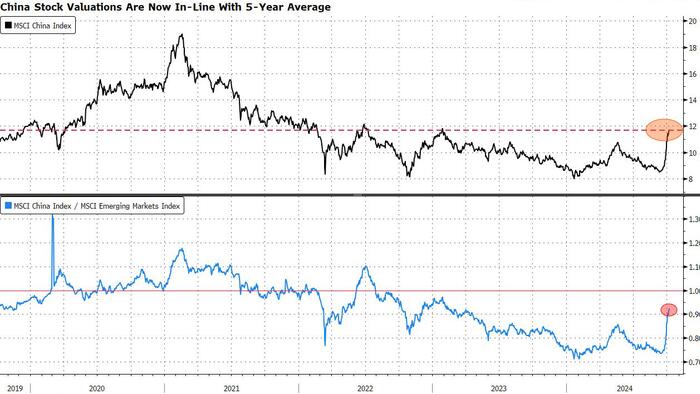In a remarkable turnaround, China’s equity market, often viewed as one of the most undervalued globally, swiftly transformed from a laggard to a leader, thanks to an aggressive round of government stimulus. This rapid recovery highlighted a shift in market sentiment, with many investors initially perceiving the low valuations in Chinese stocks as a golden opportunity. However, this narrative may be changing as recent market dynamics suggest that the justification for such low valuations is becoming increasingly tenuous. Analysts are now reassessing the underlying factors that drove this surge in stock prices, particularly the influential role of fiscal and monetary policies enacted by the Chinese government.
The stimulus measures introduced aimed to invigorate a slowing economy, and the rapid rebound in market performance has caught many off guard. Previously characterized by a lack of investor confidence and fears over economic stability, the Chinese market is now experiencing newfound optimism. Yet, this shift raises critical questions about the sustainability of these gains. Investors are beginning to realize that the market’s recovery may not be solely based on solid fundamentals but rather on temporary boosts provided by policy interventions.
Despite the initial excitement, valuations in China are no longer perceived as bargain-basement prices. Previous arguments advocating for investment in undervalued Chinese stocks relied heavily on the premise that their low prices indicated a potential for recovery. However, with the market’s recent rally, these valuations have climbed back to or exceeded average levels, dampening the allure that once drew in investors. Consequently, a more cautious approach is emerging, as market participants begin to weigh the implications of higher valuations against the backdrop of declining corporate profitability.
Long-term profitability, particularly reflected in the return on equity (ROE) metrics for major Chinese corporations, is a significant cause for concern. A consistent decline in ROE is indicative of broader structural issues within the Chinese economy, suggesting that companies are generating less profit relative to their equity base. This ongoing trend signals that the potential for solid returns on investment may be limited, creating a more challenging environment for equity valuations. As a result, even as prices have surged, the fundamental strength of China Inc. remains questionable.
In light of these developing trends, market strategies are undergoing reevaluation. Investors who once rushed to capitalize on what appeared to be undervalued stocks are now adopting a more nuanced approach, paying closer attention to the economic indicators that impact profitability. It appears that the narrative of cheap valuations has lost momentum, as the risks associated with investing in Chinese equities grow more apparent. Market participants are becoming increasingly aware that the decline in profitability could lead to further downward pressure on valuations, even in the face of continued government support.
Ultimately, while the recent rebound in China’s equity market was impressive, the factors contributing to this change are more complex than mere valuation metrics. As the realities of long-term profitability and market sustainability come into sharper focus, investors are urged to proceed with caution. The future trajectory of China’s stock market will depend heavily on economic recovery, corporate governance, and the efficacy of governmental policies—as well as the ability of Chinese companies to adapt to evolving market conditions. The opportunities may still exist, but a more discerning investment strategy is needed to navigate this rapidly changing landscape.

